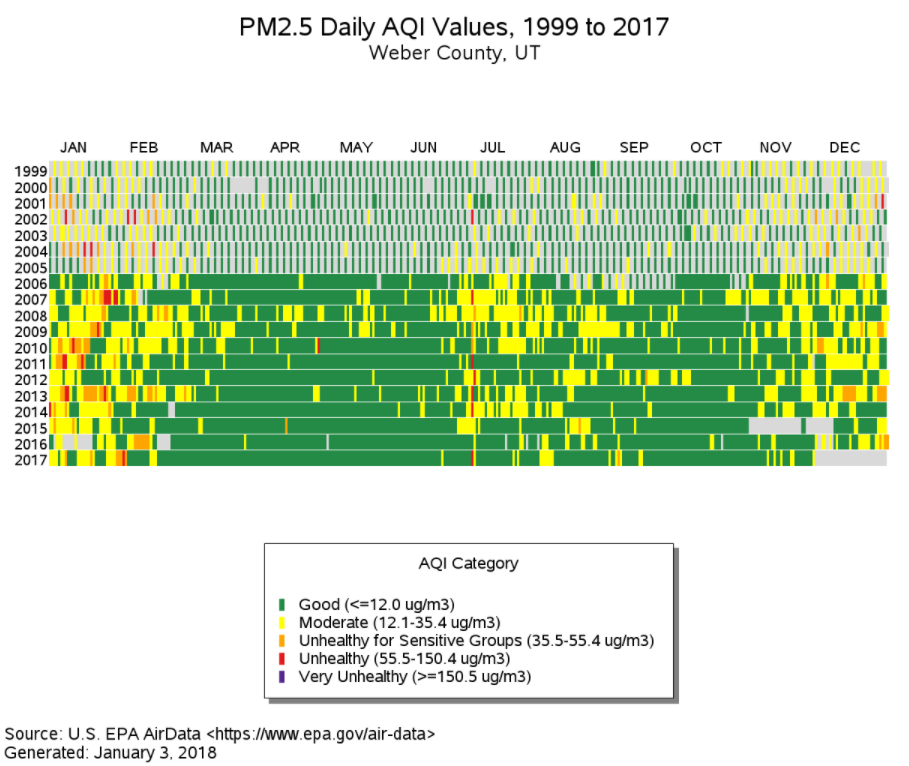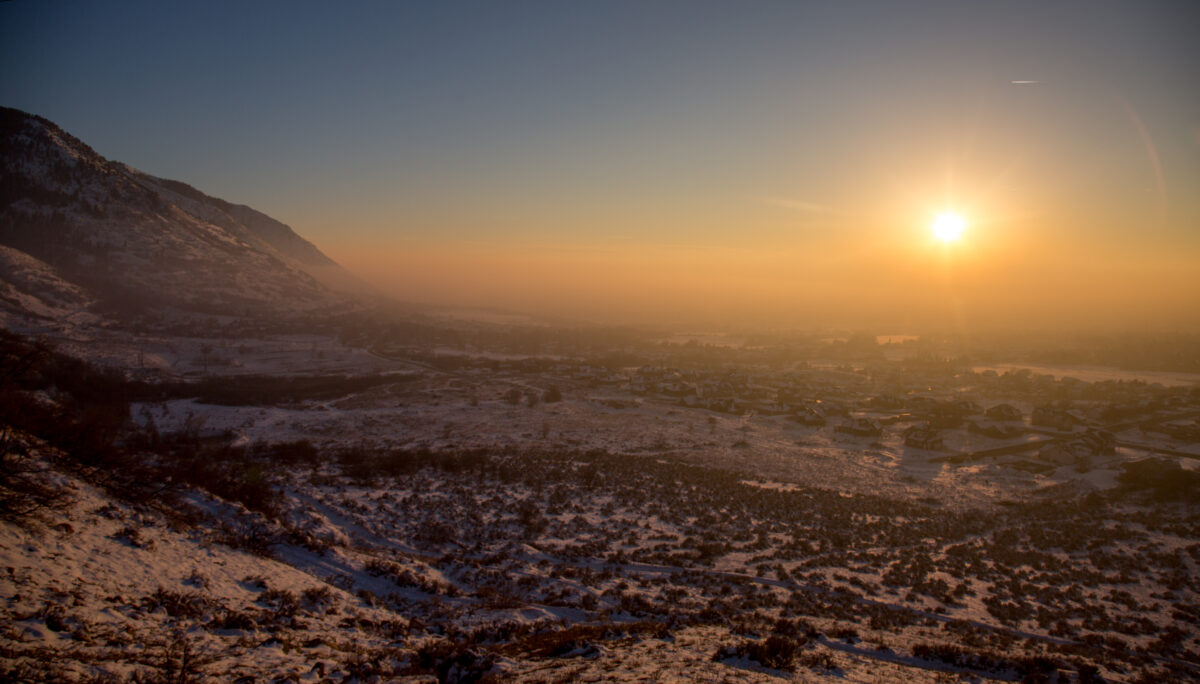Despite the inversion, Utah’s air is actually better than it used to be
The Wasatch Front ended 2017 in the thick of another inversion. Meanwhile, Utah Sen. Todd Weiler found himself in a Twitter storm about air quality.
The Republican lawmaker took to the platform to remind Utahns that inversion pollution has improved over time. He noted that when the gunky smog builds, cars and homes are mostly to blame — not factories, refineries or copper mines. He went even further, saying it was “intellectually dishonest” to argue Utah’s air quality is getting worse.
Weiler’s tweets generated a backlash, but it turns out, he’s right — at least about the region’s sources of pollution and its improvement over time.
3. Most of the pollution you see during inversions is from people driving their cars and heating their homes. 4. Even if we do nothing, Utah’s air will continue to get cleaner every year for the next decade. This is mostly because Tier 3 cars and fuel are becoming available.
— Todd Weiler (@gopTODD) December 29, 2017
“I think with air quality, it’s hard,” Weiler said. “People don’t take the time to do the research and I think a lot of people repeat things that aren’t true and hear them over and over so often that they just believe them.”
RELATED: Five basic inversion questions and the answers you should know
The Utah Division of Air Quality posts data on wintertime particulate pollution online back to 2000. Crunch the numbers and it’s true, the long-term trend shows fewer red days during inversion spells and daily levels of pollution concentrations that have improved through the years.
“We know weather is variable, but looking at the long-term trends, even with prolonged inversions, we don’t see the concentrations get to the levels they would have in the past,” said DAQ Director Bryce Bird.
The University of Utah actually made a visually compelling, interactive graphic that shows the reduction of red days over the past 35 years, at least for Salt Lake City.
Air quality regulators at the state and federal levels are able to track those improvements because they make comprehensive inventories every three years.
“We are able to show, even with population increasing and the amount of travel increasing, the amount of emissions are actually going down,” Bird said.
Those improvements are almost entirely due to tightening federal regulations. Revisions to the Clean Air Act have required tougher engineering on industrial emitters, like factories and mining operations. They’ve required cleaner fuels, which has helped improve both vehicle emissions and refinery emissions. They’ve also phased in more efficient cars.
Smaller-scale state initiatives help, too, like 2015’s DAQ-sponsored lawn mower discount and exchange.
“I think we tend to forget over time how bad it used to be,” Bird said. “If we had an inversion like we did in December, but back in 1986, our (pollution) concentrations would likely have been double.”
Federal regulations, however, continue to get stricter, so even as Utah’s air quality improves over time it fails to meet pollution standards.
In fact, a recent re-tooling of ozone pollution standards means Utah will likely fall into non-attainment for its summertime pollution, too.
RELATED: EPA sets new ozone regulations and basically no one is happy
“So we need to do more and we’re actively working to identify additional places we can reduce (pollution),” Bird said.
The emissions inventories required by regulators also quantify where the pollution is coming from. Almost half — 48 percent — of emissions during a Wasatch Front inversion come from mobile sources, which include cars, trucks and other combustion engines. The next biggest chunk, 39 percent, comes from homes and small businesses, including wood burning. Industry generates 13 percent of emissions.
In other words, the biggest source of pollution in the region is people driving, heating their homes or going to work.
Still, Bird said he understands the public’s frustrations. The air quality may be improving, but we all feel the impacts during bouts of prolonged pollution. Those health impacts are real, from asthma to lung cancer, from canceled recess to complications during pregnancy. And they can leave people feeling helpless.
RELATED: How does inversion affect health of adults, children, pregnant women and more?
“Sometimes when we focus on the improvements, it sends the message we’re not doing all we can do to address what remains,” Bird said. “In my career here, I look at where things when I started and where things are now. I take pride in the work we’ve done as an agency. But we’re clearly not there yet.”
RELATED: The basics of Utah’s air quality regulations and management
It’s hard to change the daily actions of 2 million people living on the Wasatch Front. That may be why some Utahns reacted angrily to Weiler’s inversion tweets.
The inversion isn’t human caused, the poison air in the inversion is. It’s disingenuous to say there is nothing we can do. People are sick & dying because humans polute air. Many would call this a public heath crisis & we CAN change pollution #science #utpol
— LaR.R.y D. Curtis (@MrLDC) December 30, 2017
“There’s a real lack of willingness to accept personal responsibility,” Weiler said. “Everyone wants to point finger at refineries, at the Legislature, at Kennecott. Nobody is willing to look in the mirror and say, ‘Gee, maybe I could be doing my part.'”
That finger-pointing is what prompted Weiler to shoot off his tweets in the first place, he said, after being tagged in another social media post blaming the Legislature for Utah’s air problems.
5. Employers allowing telecommuting during Red days. 6. Stricter emission guidelines on vehicles. 7. Continued individual tax incentives on solar and wind power development and use. 8. Continued development, encouragement, and incentives for electric and NGV vehicles.
— Jonathan A. Gochberg (@GochFather) December 31, 2017
The lawmaker pointed out a long list of bills and appropriations since 2014 that tackle the state’s air quality problems or incentivize improvements, from funding air quality research to allowing the Division of Motor Vehicles to revoke registrations of polluting vehicles.
Weiler admits most of those measures are small. They don’t do much to curb daily polluting habits, which would make the biggest difference.
RELATED: Five surprising ways to improve Utah’s inversion pollution
“There are people who want me, as a legislator, to tell neighbors they can’t drive their cars, or they can only drive on certain days,” he said. “But this is America, we have a constitution, property rights, all kinds of freedoms. We have to be very careful as a government before we start micromanaging peoples’ lives.”
Yes, except this isn’t Iran. Or North Korea.
— Todd Weiler (@gopTODD) December 30, 2017
He pointed to a 2014 proposal by Gov. Gary Herbert to ban winter wood burning, which comprises an estimated 6 percent of inversion pollution. The initiative backfired, rejected by residents all along the Wasatch Front.
RELATED: Proposed wood burning ban sparks controversy
“Again, people don’t want the government to tell them they’re part of the problem,” Weiler said. “That’s the reason I sent out the tweets, even though I know I’m going to get attacked and ridiculed and mocked. I think we need to start a discussion that will educate people. … There are things that can be done; it’s a shared responsibility.”
Contact Reporter Leia Larsen at 801-625-4289 or llarsen@standard.net. Follow her on Facebook.com/leiainthefield or on Twitter @LeiaLarsen.




